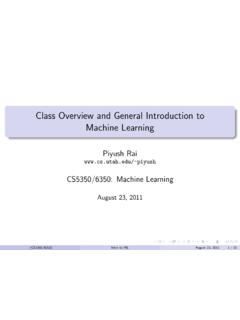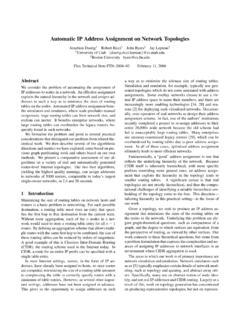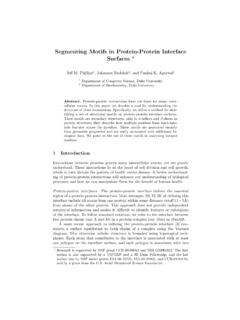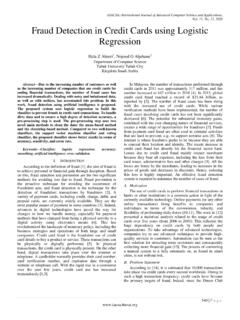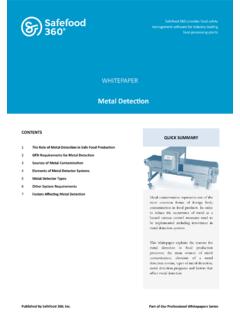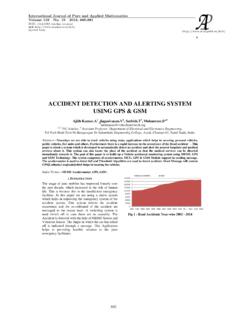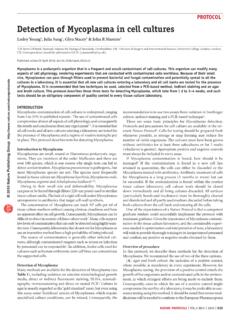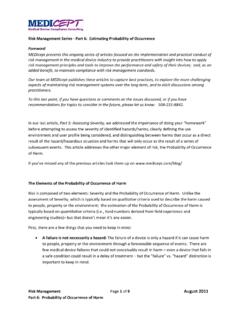Transcription of DeepLog: Anomaly Detection and Diagnosis from System …
1 deeplog : Anomaly Detection and Diagnosis from System Logsthrough Deep LearningMin Du, Feifei Li, Guineng Zheng, Vivek SrikumarSchool of Computing, University of Utah{mind, lifeifei, guineng, Detection is a critical step towards building a secure andtrustworthy System . e primary purpose of a System log is torecord System states and signi cant events at various critical pointsto help debug System failures and perform root cause analysis. Suchlog data is universally available in nearly all computer data is an important and valuable resource for understandingsystem status and performance issues; therefore, the various sys-tem logs are naturally excellent source of information for onlinemonitoring and Anomaly Detection . We propose deeplog , a deepneural network model utilizing Long Short-Term Memory (LSTM),to model a System log as a natural language sequence. is allowsDeepLog to automatically learn log pa erns from normal execution,and detect anomalies when log pa erns deviate from the modeltrained from log data under normal execution.}
2 In addition, wedemonstrate how to incrementally update the deeplog model inan online fashion so that it can adapt to new log pa erns over , deeplog constructs work ows from the underlyingsystem log so that once an Anomaly is detected, users can diagnosethe detected Anomaly and perform root cause analysis e experimental evaluations over large log data have shownthat deeplog has outperformed other existing log-based anomalydetection methods based on traditional data mining CONCEPTS Information systems Online analytical processing; Securityand privacy Intrusion/ Anomaly Detection and malware mitiga-tion;KEYWORDSA nomaly Detection ; deep learning; log data INTRODUCTIONA nomaly Detection is an essential task towards building a secureand trustworthy computer System . As systems and applicationsget increasingly more complex than ever before, they are subjectto more bugs and vulnerabilities that an adversary may exploit tolaunch a acks.
3 Such a acks are also ge ing increasingly moresophisticated. As a result, Anomaly Detection has become morePermission to make digital or hard copies of all or part of this work for personal orclassroom use is granted without fee provided that copies are not made or distributedfor pro t or commercial advantage and that copies bear this notice and the full citationon the rst page. Copyrights for components of this work owned by others than ACMmust be honored. Abstracting with credit is permi ed. To copy otherwise, or republish,to post on servers or to redistribute to lists, requires prior speci c permission and/or afee. Request permissions from 17, Oct. 30 Nov. 3, 2017, Dallas, TX, USA. 2017 ACM. ISBN 978-1-4503-4946-8/17/10..$ : h and many traditional Anomaly Detection methods basedon standard mining methodologies are no longer e logs record System states and signi cant events at variouscritical points to help debug performance issues and failures, andperform root cause analysis.
4 Such log data is universally availablein nearly all computer systems and is a valuable resource for un-derstanding System status. Furthermore, since System logs recordnoteworthy eventsas they occurfrom actively running processes,they are an excellent source of information for online monitoringand Anomaly approaches that leverage System log data for anomalydetection can be broadly classi ed into three groups: PCA basedapproaches over log message counters [39], invariant mining basedmethods to capture co- occurrence pa erns between di erent logkeys [21], and work ow based methods to identify execution anom-alies in program logic ows [42]. Even though they are successful incertain scenarios, none of them is e ective as a universal anomalydetection method that is able to guard against di erent a acks inan online fashion. is work proposes deeplog , a data-driven approach for anom-aly Detection that leverages the large volumes of System logs.
5 Ekey intuition behind the design of deeplog is from natural lan-guage processing: we view log entries as elements of a sequencethat follows certain pa erns and grammar rules. Indeed, a sys-tem log is produced by a program that follows a rigorous set oflogic and control ows, and is very much like a natural language(though more structured and restricted in vocabulary). To that end, deeplog is a deep neural network that models this sequence of logentries using a Long Short-Term Memory (LSTM) [18]. is allowsDeepLog to automatically learn a model of log pa erns from nor-mal execution and ag deviations from normal System executionas anomalies. Furthermore, since it is a learning-driven approach,it is possible to incrementally update the deeplog model so that itcan adapt to new log pa erns that emerge over data are unstructured, and their format and se-mantics can vary signi cantly from System to System . It is alreadychallenging to diagnose a problem using unstructured logs evena er knowing an error has occurred [43]; online Anomaly detectionfrom massive log data is even more challenging.
6 Some existingmethods use rule-based approaches to address this issue, whichrequires speci c domain knowledge [41], , using features like IP address to parse a log. However, this does not work for generalpurpose Anomaly Detection where it is almost impossible to knowa priori what areinteresting featuresin di erent types of logs (andto guard against di erent types of a acks). Anomaly Detection has to be timely in order to be useful so thatusers can intervene in an ongoing a ack or a System performanceissue [10]. Decisions are to be made in streaming fashion. Asa result, o ine methods that need to make several passes overthe entire log data are not applicable in our se ing [22,39]. Wewould also like to be able to detectunknowntypes of anomalies,rather than gearing towards speci c types of anomalies. erefore,previous work [44] that use both normal and abnormal (for speci ctypes of anomalies) log data entries to train a binary classi er foranomaly Detection is not useful in this challenge comes from concurrency.
7 Clearly, the or-der of log messages in a log provides important information fordiagnosis and analysis ( , identify the execution path of a pro-gram). However, in many System logs, log messages are producedby several di erent threads or concurrently running tasks. Suchconcurrency makes it hard to apply work ow based Anomaly de-tection methods [42] which use a work ow model for a single taskas a generative model to match against a sequence of log , each log message contains rich information such as a logkey and one or more metric values, as well as its timestamp. Aholistic approach that integrates and utilizes these di erent piecesof information will be more e ective. Most existing methods [22,32,39,41,42,44] analyze only one speci c part of a log message( , the log key) which limits the types of anomalies they Recurrent Neural Network (RNN) is an arti- cial neural network that uses a loop to forward the output of laststate to current input, thus keeping track of history for making pre-dictions.
8 Long Short-Term Memory (LSTM) networks [13,18,27]are an instance of RNNs that have the ability to remember long-termdependencies over sequences. LSTMs have demonstrated successin various tasks such as machine translation [35], sentiment analy-sis [8], and medical self- Diagnosis [20].Inspired by the observation that entries in a System log areasequence of events produced by the execution of structured sourcecode (and hence can be viewed as a structured language), we designthe deeplog framework using a LSTM neural network for onlineanomaly Detection over System logs. deeplog uses not only logkeys but also metric values in a log entry for Anomaly Detection ,hence, it is able to capture di erent types of anomalies. DeepLogonly depends on a small training data set that consists of a sequenceof normal log entries . A er the training phase, deeplog canrecognize normal log sequences and can be used for online anomalydetection over incoming log entries in a streaming , deeplog implicitly captures the potentially non-linear and high dimensional dependencies among log entries fromthe training data that correspond to normal System execution help users diagnose a problem once an Anomaly is identi ed, deeplog also builds work ow models from log entries during itstraining phase.
9 deeplog separates log entries produced by concur-rent tasks or threads into di erent sequences so that a work owmodel can be constructed for each separate evaluation shows that on a large HDFS log dataset exploredby previous work [22,39], trained on only a very small fraction(less than 1%) of log entries corresponding to normal System exe-cution, deeplog can achieve almost 100% Detection accuracy onthe remaining 99% of log entries. Results from a large OpenStacklog convey a similar trend. Furthermore, deeplog also providesthe ability to incrementally update its weights during the detec-tion phase by incorporating live user feedback. More speci cally, deeplog provides a mechanism for user feedback if a normal logentry is incorrectly classi ed as an Anomaly . deeplog can then usesuch feedback to adjust its weights dynamically online over timeto adapt itself to new System execution (hence, new log) pa Log parserWe rst parse unstructured, free-text log entries into a structuredrepresentation, so that we can learn a sequential model over thisstructured data.
10 As shown by several prior work [9,22,39,42,45],an e ective methodology is to extract a log key (also known as message type ) from each log entry. e log key of a log entryerefers to the string constantkfrom the print statement in the sourcecode which printededuring the execution of that code. For example,the log keykfor log entrye= Took 10 seconds to build instance. isk=Took * seconds to build instance., which is the string constant fromthe print statementprintf( Took %f seconds to build instance. , t). Notethat the parameter(s) are abstracted as asterisk(s) in a log key. esemetric values re ect the underlying System state and performancestatus. Values of certain parameters may serve as identi ers fora particular execution sequence, such asblock_idin a HDFS logandinstance_idin an OpenStack log. ese identi ers can grouplog entries together or untangle log entries produced by concurrentprocesses to separate, single-thread sequential sequences [22,39,42,45].
